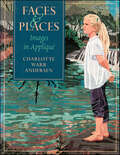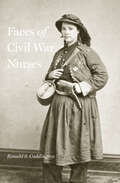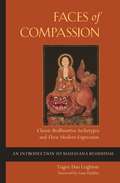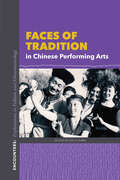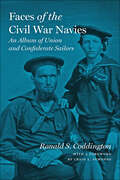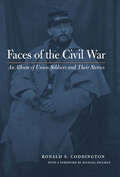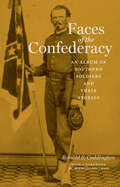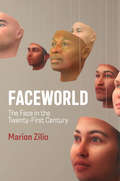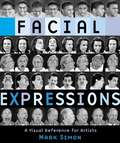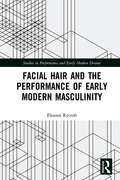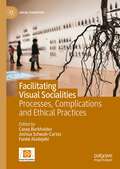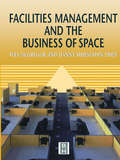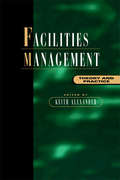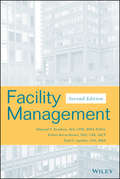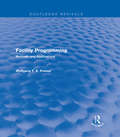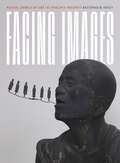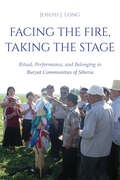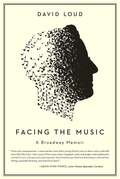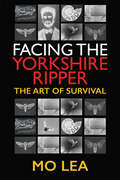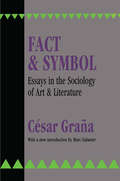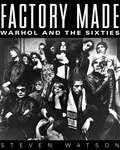- Table View
- List View
Faces & Places: Images in Appliqué
by Charlotte Warr AndersenHave you ever wanted to create a quilt from a favorite photograph but didn't know how to begin? Capturing realistic details in fabric seems an elusive art, but Charlotte shows how to portray images in quilts using a layering technique that is easy to understand and easy to use. Now you can create images in fabric through the appliqué techniques and exercises discussed in this exciting new book. A photo sequence for each project guides the quilter through the process. The projects include landscapes and portraits, with step-by-step techniques to capture realistic detail. *Important Note about PRINT ON DEMAND Editions: This title will be printed after purchase and will arrive separately from any in-stock items. Please allow approximately 2 weeks for USA delivery, with an additional 2 weeks for international shipments. Expedited shipping is not available on POD Editions. The printing quality in this copy will vary from the original offset printing edition and may look more saturated due to printing on demand by a high-quality printer on uncoated (non-glossy) paper. The information presented in this version is the same as the most recent printed edition. Any pattern pullouts have been separated and presented as single pages.
Faces of Civil War Nurses
by Ronald S. CoddingtonA collection of rare archival images and biographical sketches of the dauntless women who served as nurses and caregivers during the Civil War.During the American Civil War, women on both sides of the conflict, radiating patriotic fervor equal to their male counterparts, contributed to the war effort in countless ways: forming charitable societies, becoming nurses, or even marching off to war as vivandières, unofficial attachés to the regiments.In Faces of Civil War Nurses, Ronald S. Coddington turns his attention to the experiences of 77 women of all ages and walks of life who provided care during the war as nurses, aid workers, and vivandières. Their personal narratives are as unique as fingerprints: each provides a distinct entry point into the larger social history of the brutal and bloody conflict. Coddington tells these determined women's stories through letters, diaries, pension files, and newspaper and government reports. Using identified tintypes and cartes de visite of women on both sides of the war, many of them never before published, Coddington uncovers the personal histories of each intrepid individual. Following their postwar stories, he also explains how the bonds they formed continued long after the cessation of hostilities. The fifth volume in Coddington's series on Civil War soldiers, this captivating microhistory will appeal to anyone with an interest in the Civil War, women's studies, social history, nursing, or photography. Praise for Ronald Coddington's Faces Series"An engaging look at a neglected part of the history of the American Civil War."—Booklist"Coddington has hit upon a unique and fascinating niche in the seemingly endless march of Civil War books."—C&RL News"A lavishly produced visual record of southern Civil War soldiers... will appeal to serious photography enthusiasts and collectors, as well as those readers captivated by the personal stories of Civil War soldiers."—Civil War Books and Authors"Coddington's prose is as unpretentious as the faces he shares, yet authoritative. It resurrects details that broaden our understanding of those sad times and sheds valuable light on the shape of modern culture."—Atlanta Constitution"Even at a distance of over a hundred years, the faces staring out of these pages create an undeniable emotional connection with the reader. This book is highly recommended."—H-CivWar, H-Net Reviews"A fascinating window into the war's impact on the individual soldier... well researched and engagingly written. Any teacher of the Civil War would do well to consult this volume and incorporate some of the captivating tales into lectures and readings."—Journal of Military History
Faces of Compassion: Classic Bodhisattva Archetypes and Their Modern Expression — An Introduction to Mahayana Buddhism
by Taigen Dan Leighton Joan Halifax RoshiFaces of Compassion introduces us to enlightened beings, the bodhisattvas of Buddhist lore. They're not otherworldly gods with superhuman qualities but shining examples of our own highest potential. Archetypes of wisdom and compassion, the bodhisattvas of Buddhism are powerful and compelling images of awakening. Scholar and Zen teacher Taigen Dan Leighton engagingly explores the imagery and lore of the seven most important of these archetypal figures, bringing them alive as psychological and spiritual wellsprings. Emphasizing the universality of spiritual ideas, Leighton finds aspects of bodhisattvas expressed in a variety of familiar modern personages - from Muhammad Ali to Mahatma Gandhi, from Bob Dylan to Henry Thoreau, and from Gertrude Stein to Mother Teresa. This edition contains a revised and expanded introduction that frames the book as a exciting and broad-scoped view of Mahayana Buddhism. It's updated throughout to make it of more use to scholars and a perfect companion to survey courses of world religions or a 200-level course on Buddhism.
Faces of Tradition in Chinese Performing Arts (Encounters: Explorations in Folklore and Ethnomusicology)
by Levi S. GibbsCase studies examining the individual’s role in how traditional Chinese performing arts like music and dance are represented, maintained, and cultivated.Faces of Tradition in Chinese Performing Arts examines the key role of the individual in the development of traditional Chinese performing arts such as music and dance. These artists and their artistic works—the “faces of tradition” —come to represent and reconfigure broader fields of cultural production in China today. The contributors to this volume explore the ways in which performances and recordings, including singing competitions, textual anthologies, ethnographic videos, and CD albums, serve as discursive spaces where individuals engage with and redefine larger traditions and themselves. By focusing on the performance, scholarship, collection, and teaching of instrumental music, folksong, and classical dance from a variety of disciplines—these case studies highlight the importance of the individual in determining how traditions have been and are represented, maintained, and cultivated.“Faces of Tradition in Chinese Performing Arts [examines] the dynamic relationship between individual representatives of tradition and the evolution of the traditions themselves.” —A. C. Shahriari, Kent State University, Choice
Faces of the Civil War Navies: An Album of Union and Confederate Sailors
by Ronald S. CoddingtonArchival images and biographical sketches of common sailors on both sides of the conflict reveal the human side of the Civil War.During the American Civil War, more than one hundred thousand men fought on ships at sea or on one of America’s great inland rivers. There were no large-scale fleet engagements, yet the navies, particularly the Union Navy, did much to define the character of the war and affect its length. The first hostile shots roared from rebel artillery at Charleston Harbor. Along the Mississippi River and other inland waterways across the South, Union gunboats were often the first to arrive in deadly enemy territory. In the Gulf of Mexico and along the Atlantic seaboard, blockaders in blue floated within earshot of gray garrisons that guarded vital ports. And on the open seas, rebel raiders wreaked havoc on civilian shipping. In Faces of the Civil War Navies, renowned researcher and Civil War photograph collector Ronald S. Coddington focuses his considerable skills on the Union and Confederate navies. Using identifiable cartes de visite of common sailors on both sides of the war, many of them never before published, Coddington uncovers the personal histories of each individual who looked into the eye of the primitive camera. These unique narratives are drawn from military and pension records, letters, diaries, period newspapers, and other primary sources. In addition to presenting the personal stories of seventy-seven intrepid volunteers, Coddington also focuses on the momentous naval events that ushered in an era of ironclad ships and other technical innovations. The fourth volume in Coddington’s series on Civil War soldiers, this microhistory will appeal to anyone with an interest in the Civil War, social history, or photography. The narratives and photographs in Faces of the Civil War Navies shed new light on a lesser-known part of our American story. Taken collectively, these "snapshots" remind us that the history of war is not merely a chronicle of campaigns won and lost, it is the collective personal odysseys of thousands of individual life stories.
Faces of the Civil War: An Album of Union Soldiers and Their Stories
by Ronald S. CoddingtonArchival images and biographical sketches of Union soldiers tell the stories of their lives during and after the Civil War.Before going off to fight in the Civil War, many soldiers on both sides of the conflict posed for a carte de visite, or visiting card, to give to their families, friends, or sweethearts. Invented in 1854 by a French photographer, the carte de visite was a small photographic print roughly the size of a modern trading card. The format arrived in America on the eve of the Civil War, which fueled intense demand for the convenient and affordable keepsakes. Considerable numbers of these portrait cards of Civil War soldiers survive today, but the experiences—and often the names—of the individuals portrayed have been lost to time. A passionate collector of Civil War–era photography, Ron Coddington became intrigued by these anonymous faces and began to research the history behind them in military records, pension files, and other public and personal documents.In Faces of the Civil War, Coddington presents 77 cartes de visite of Union soldiers from his collection and tells the stories of their lives during and after the war. The soldiers portrayed were wealthy and poor, educated and unschooled, native-born and immigrant, urban and rural. All were volunteers. Their personal stories reveal a tremendous diversity in their experience of war: many served with distinction, some were captured, some never saw combat while others saw little else. The lives of those who survived the war were even more disparate. While some made successful transitions back to civilian life, others suffered permanent physical and mental disabilities, which too often wrecked their families and careers. In compelling words and haunting pictures, Faces of the Civil War offers a unique perspective on the most dramatic and wrenching period in American history.
Faces of the Confederacy: An Album of Southern Soldiers and Their Stories
by Ronald S. Coddington"The history of the Civil War is the stories of its soldiers," writes Ronald S. Coddington in the preface to Faces of the Confederacy. This book tells the stories of seventy-seven Southern soldiers—young farm boys, wealthy plantation owners, intellectual elites, uneducated poor—who posed for photographic portraits, cartes de visite, to leave with family, friends, and sweethearts before going off to war. Coddington, a passionate collector of Civil War–era photography, conducted a monumental search for these previously unpublished portrait cards, then unearthed the personal stories of their subjects, putting a human face on a war rife with inhuman atrocities. The Civil War took the lives of 22 of every 100 men who served. Coddington follows the exhausted survivors as they return home to occupied cities and towns, ravaged farmlands, a destabilized economy, and a social order in the midst of upheaval. This book is a haunting and moving tribute to those brave men. Like its companion volume, Faces of the Civil War: An Album of Union Soldiers and Their Stories, this book offers readers a unique perspective on the war and contributes to a better understanding of the role of the common soldier.
Faces of the Confederacy: An Album of Southern Soldiers and Their Stories
by Ronald S. Coddington“Extensive research, fascinating characters . . . The author has done an admirable job of literally placing a face on the ordinary Confederate soldier.” —The Journal of Southern History“The history of the Civil War is the stories of its soldiers,” writes Ronald S. Coddington in the preface to Faces of the Confederacy. This book tells the stories of seventy-seven Southern soldiers—young farm boys, wealthy plantation owners, intellectual elites, uneducated poor—who posed for photographic portraits, cartes de visite, to leave with family, friends, and sweethearts before going off to war. Coddington, a passionate collector of Civil War-era photography, conducted a monumental search for these previously unpublished portrait cards, then unearthed the personal stories of their subjects, putting a human face on a war rife with inhuman atrocities.The Civil War took the lives of twenty-two of every hundred men who served. Coddington follows the exhausted survivors as they return home to occupied cities and towns, ravaged farmlands, a destabilized economy, and a social order in the midst of upheaval. This book is a haunting and moving tribute to those brave men.Like its companion volume, Faces of the Civil War: An Album of Union Soldiers and Their Stories, this book offers readers a unique perspective on the war and contributes to a better understanding of the role of the common soldier.“With his meticulous research and a journalist’s eye for good stories, Ron Coddington has brought new life to Civil War photographic portraits of obscure and long-forgotten Confederates whose wartime experiences might otherwise have been lost to history.” —Bob Zeller, cofounder and president of the nonprofit Center for Civil War Photography
Faceworld
by Marion ZilioWe have long accepted the face as the most natural and self-evident thing, believing that in it we could read, as if on a screen, our emotions and our doubts, our anger and joy. We have decorated them, made them up, designed them, as if the face were the true calling card of our personality, the public manifestation of our inner being. Nothing could be further from the truth. Rather than a window opening onto our inner nature, the face has always been a technical artefact—a construction that owes as much to artificiality as to our genetic inheritance. From the origins of humanity to the triumph of the selfie, Marion Zilio charts the history of the technical, economic, political, legal, and artistic fabrication of the face. Her account of this history culminates in a radical new interrogation of what is too often denounced as our contemporary narcissism. In fact, argues Zilio, the “narcissism” of the selfie may well reconnect us to the deepest sources of the human manufacture of faces—a reconnection that would also be a chance for us to come to terms with the non-human part of ourselves. This highly original reflection on the fabrication of the face will be of great value to students and scholars of media and culture and to anyone interested in the pervasiveness of the face in our contemporary age of the selfie.
Facial Expressions: A Visual Reference for Artists
by Mark SimonAll artists are tired of persuading their nearest and dearest to look sad...look glad...look mad...madder...no, even madder...okay, hold it. For those artists (and their long-suffering friends), here is the best book ever. Facial Expressions includes more than 2,500 photographs of 50 faces--men and women of a variety of ages, shapes, sizes, and ethnicities--each demonstrating a wide range of emotions and shown from multiple angles. Who can use this book? Oh, only every artist on the planet, including art students, illustrators, fine artists, animators, storyboarders, and comic book artists. But wait, there's more! Additional photos focus on people wearing hats and couples kissing, while illustrations show skull anatomy and facial musculature. Still not enough? How about a one-of-a-kind series of photos of lips pronouncing the phonemes used in human speech? Animators will swoon--and artists will show a range of facial expressions from happy to happiest to ecstatic.From the Trade Paperback edition.
Facial Hair and the Performance of Early Modern Masculinity (Studies in Performance and Early Modern Drama)
by Eleanor RycroftFacial Hair and the Performance of Early Modern Masculinity is the first full-length critical study to analyse the importance of beards in terms of the theatrical performance of masculinity. According to medical, cultural, and literary discourses of early modern era in England, facial hair marked adult manliness while beardlessness indicated boyhood. Beards were therefore a passport to cultural prerogatives. This book explores this in relation to the early modern stage, a space in which the processes of gender formation in early modern society were writ large, and how the uses of facial hair in the theatre illuminate the operations of power and politics in society more widely. Written for scholars of Early Modern Theatre and Theatre History, this volume anatomises the role of beards in the construction of onstage masculinity, acknowledging the challenges offered to the dominant ideology of manliness by boys and men who misrepresented or failed to fulfil bearded masculine ideals.
Facilitating Visual Socialities: Processes, Complications and Ethical Practices (Social Visualities)
by Casey Burkholder Joshua Schwab-Cartas Funké AladejebiThis edited collection seeks to enrich the dialogue about the expansive possibilities of visual sociological research facilitation. Although facilitating ethical research has long been identified within medical research literatures, there is a dearth of distinct perspectives and voices in academic theorizing when it comes to facilitating ethical research. For example, how can researchers learn and incorporate community created approaches to facilitation into their visual research approaches? Although ethics, positionality, and reflexivity remain important components of visual research, the authors argue that the incremental decisions made in real time by research facilitators within the process of visual research is currently under-theorized. This edited collection seeks to discuss how thinking about facilitation in a more critical and nuanced manner, as well as thinking through the kinds of relations, problems and local changes that happen within a project, can help visual sociological researchers move towards more equitable research practices.
Facilities Management Models, Methods and Tools: Research Results for Practice
by Per JensenThis book presents research tested models, methods and tools that can make the work of the facilities manager more robust and sustainable, help long-term strategic planning and support students and practitioners in FM to improve the way they approach and deal with challenges in practice. The 34 models, methods and tools are presented in relation to five typical challenges for facilities managers: Strategy development Organisational design Space planning Building projects Optimisation The chapters are short and concise, presenting a central illustration of one model, method or tool with explanatory text and short, exemplary case studies. Each chapter includes references to further reading, and the book includes a keyword index. Essential reading for all involved in the management of built assets, this book bridges the gap between robust academic research and practical industry tools. It can also be used as a handy student reference.
Facilities Management and the Business of Managing Assets
by Danny Then Shiem-Shin Tan Teng HeeThe importance of facilities management to the effective operation of all businesses is now widely accepted. Where there continues to be debate is on what constitutes a successful approach, and how much attention it should be given within an overall business plan. Drawing on both research and current practice, this book provides a systematic, innovative, and business-focused approach to the management of facilities assets. The reader will discover why and how to use facility assets to achieve business goals and strategies by aligning them as a resource. Striking a balance between management and technical aspects, the book covers: the basics of facilities asset management and the key elements of a systematic management approach the key supporting capabilities for facilities management as a business function a framework for considering strategic alignment of facilities assets and associated services with business needs the role of life-cycle asset management and its contribution to business resource management. The message of this book and the benefits it can bring to businesses everywhere make it essential reading for executives as well as facilities managers. Its detailed explanations of all of the key concepts involved, and lists of recommended further reading also make it an excellent resource for those new to the industry, and for students of property or facilities management.
Facilities Management and the Business of Space
by Wes McGregorEssential reading for building owners, facilities managers, architects and surveyors, this book will also prove useful on business management and facilities management courses, and for those studying architecture, surveying and real estate management.
Facilities Management: Innovation and Performance
by Keith Alexander, Brian Atkin, Jan Bröchner and Tore I. HaugenFacilities Management sets out a new framework for the discipline of facilities management which challenges many of the norms and which sets out new methods for optimising the performance of a business. Successful facilities managers need a range of skills and need to be able to devise a range of innovative strategies for the future of the organisations in which they work.This new book follows on directly from Keith Alexander's ground-breaking textbook Facilities Management and focuses on four new themes which have been identified as keys to the new strategy: organisational change and learning, innovation, performance and the knowledge workplace.
Facilities Management: Theory and Practice
by Keith AlexanderThis text provides an overview of the interdisciplinary nature of facilities management. It discusses the framework within which facilites managers should operate and the key requirements of their task.
Facility Management
by Edmond P. Rondeau Paul D. Lapides Robert Kevin BrownFrom the moment it was first published, Facility Management became the ultimate reference for facility and design professionals who want to create a productive workplace that corresponds to the short- and long-term goals of their corporation. This Second Edition provides complete, fully up-to-date information and guidance on the evolving facility management profession that will help facility professionals and their service providers meet and exceed these goals.
Facility Programming: Methods and Applications (Routledge Revivals)
by Wolfgang F. PreiserFirst published in 1978, the objective of this book is to provide an authoritative and selective overview of current, user-orientated programming methods within the field of environmental design. The 19 chapters compiled in this volume describe procedures and the information content of innovative approaches used by leading programming experts in the private and institutional sectors. Emphasis is placed on a qualitative and illustrative focus of selected approaches to environmental programming with the eventual occupants in mind. The chapter groupings are intended to reflect three major areas of professional engagement that serve the field of facility programming. The first group describe the approaches of firms or groups that were organised exclusively to provide environmental analysis and programming services. Part II is composed of chapters by authors who belong to established architectural firms with programming departments and Part III presents evidence that pertains to the supporting role of research and guidance literature from authors primarily affiliated with government agencies or supported by large organisations.
Facing Images: Medieval Japanese Art and the Problem of Modernity (Refiguring Modernism)
by Kristopher W. KerseyIf we want to decolonize the history of art, argues Kristopher Kersey, we must rethink our approach to the historical record. This means dispensing with Eurocentric binaries—divisions between Western and non-Western, modern and premodern—and making a commitment to artworks that challenge the perspectives we build upon them. In Facing Images, the question takes elegant and intriguing form: If the aesthetic hallmarks of “modernity” can be found in twelfth-century art, what does it really mean to be “modern”?Kersey’s answer to this question models a new historiography. Facing Images begins by tracing the turbulent discourse surrounding the emergence of Japanese art history as a modern field. In lieu of examining canonical works from the twelfth century, Kersey foregrounds the elusive and the enigmatic in artworks little known and understudied outside Japan; the manuscripts he selects defy traditional art-historical narratives by exhibiting decidedly modern techniques, including montage, self-reference, reuse, noise, dissonance, and chronological disarray. Kersey weaves these medieval case studies together with insights from a wide range of interdisciplinary scholarship, using a methodology that will prove important for historians: Facing Images produces a history of non-Western art in which diverse and anachronic works are brought responsibly and equitably into dialogue with the present, without being subsumed under Eurocentric formalisms or false universals.A timely intervention in the history of medieval Japanese art, art historiography, and the history of global modernism, Facing Images redefines the relationship of the “premodern” non-West to “modern” art. It will be of particular interest to scholars of medieval Japanese art and of modernism.
Facing the Fire, Taking the Stage: Ritual, Performance, and Belonging in Buryat Communities of Siberia
by Joseph J. LongIn the mid-2000s, the Russian government began to merge Siberia's smallest Indigenous territories into larger administrative regions. Among Buryat Mongols living to the west of Lake Baikal the state promoted a policy of "National Cultural Autonomy," which sought to separate culture from territory amid this consolidation of land and people. Although public performances of Buryat culture were mobilized to show support for the policy, Joseph Long's compelling ethnography provides alternative ways to understand the meanings attached to these displays. At the same time, the book documents how resurgent local rituals demonstrated enduring ties to the land. Drawing on classic theories of ritual and performance, Facing the Fire, Taking the Stage explores how Buryat shamanism and state-sanctioned performing arts have allowed Buryats to negotiate and express different kinds of belonging to people and land. Based on several years of anthropological fieldwork in Western Buryat communities, this book provides new insights into the ways that these forms have influenced one another over time.While Buryat experience has been fundamentally shaped by Soviet communism and its aftermath, Facing the Fire, Taking the Stage shows how this history parallels the experience of Indigenous peoples worldwide.
Facing the Music: a Broadway memoir
by David LoudMusical Director and arranger David Loud, a legendary Broadway talent, recounts his wildly entertaining and deeply poignant trek through the wilderness of his childhood and the edge-of-your-seat drama of a career on, in, under, and around Broadway for decades. He reveals his struggle against the ravages of Parkinson's and triumphs repeatedly. This memoir is also a remarkable love letter to music. Loud is the 'Ted Lasso' of the theater business, ever the optimist!&“&‘Music has consequences,&’ a wise teacher once told a young David Loud; so does a story well-told and a life fully-lived. I lost count of how many times I laughed, cried, and laugh-cried reading this wonderful, wry, intimate, and inspiring book. David wields a pen like he wields a baton, with perfect timing, exquisite phrasing, and enormous heart.&” — David Hyde Pierce, actor, Frasier, Spamalot, Curtains &“Beautifully written, filled with vivid details, braided with love and loss and wit and the perspective of someone with an utterly unique story to tell." -- Lynn Ahrens, lyricist, Ragtime, Once on This Island, Anastasia &“Luminous and surprising, an extremely honest memoir of a life lived in the world of Broadway musicals, by one of the theatre&’s most gifted conductors. I can&’t think of another book quite like it.&” -- John Kander, composer, Cabaret, Chicago, New York, New York Unforgettably entertaining and emotionally revealing, Loud is pitch-perfect as he describes his path to the podium, from a stage-struck kid growing up at a school devoted to organic farming and mountain climbing, to the searing formative challenges he faces during adolescence, to the remarkable behind-the-scenes stories of his Broadway trials and triumphs. Skilled at masking his fears, Loud achieves his dream until one fateful opening night, when in the midst of a merry, dressing room celebration, he can no longer deny reality and must suddenly, truly, face the music.
Facing the Yorkshire Ripper: The Art of Survival
by Mo LeaDecades after her brutal attack by the notorious serial killer, an artist tells her story of survival and recovery in this uplifting memoir.Mo Lea was a young art student in Leeds when her life was changed forever by a deadly assault. On October 25th, 1980, serial killer Peter Sutcliffe attacked her with a hammer and stabbed her with a screwdriver. Surviving with a fractured skull and PTSD, Mo spent years wrestling with a morbid narrative that cast her as a victim. Now Mo offers a fresh perspective on her life, sharing valuable insight into her successful recovery process. While art had always been important to her, it became a vital outlet for exploring her pain, her anger, and her ultimate triumph over them. Drawing a meticulous portrait of Sutcliffe, she then found catharsis in tearing it to bits—ripping up the Ripper.In candid words and stirring illustrations, Mo reclaims her own story, telling of her journey from tragic despair to calmness and acceptance.
Fact and Symbol: Essays in the Sociology of Art and Literature
by Marc Galanter César GrañaCesar Grafla's work critically examines the continual rebirth of cultural romances on the part of literaiy Intellectuals. Grafia's disdain for contrived rejections of modernity and for grand destructive gestures is combined with his intense appreciation of the romantic sensibility. Fact and Symbol embodies Grafta’s views of the enterprise of cultural sociology in which both words are given equal play. This book consists of seven essays. Five shorter pieces on the relation of art to American democracy are bracketed by two long essays, the first on the literaiy critique of modern life, the last on Spanish American cultural nationalism. Among the temes covered throughout the book are attitudes prevalent during the post-romantic era, the French impressionists, art museums, the transformation of the industrial and commercial elite of America, and Spanish-American literary Utopians. In a new Introduction, written especially for this edition, Marc Galanter outlines Graiia’s ideas and explains what he was aiming to do when he originally wrote these essays. Fact and Symbol presents Graiia’s unique viewpoint and will be enjoyed by scholars of art and literature, as well as sociologists. One can well appreciate why this book was nominated for a National Book Award on its original release. It is a pioneering achievement in the sociology of culture.
Factory Made
by Steven WatsonFactory Made: Warhol and the Sixties is a fascinating look at the avant-garde group that came together--from 1964 to 1968--as Andy Warhol's Silver Factory, a cast that included Lou Reed, Nico, Edie Sedgwick, Gerard Malanga, Paul Morrissey, Joe Dallesandro, Billy Name, Candy Darling, Baby Jane Holzer, Brigid Berlin, Ultra Violet, and Viva. Steven Watson follows their diverse lives from childhood through their Factory years. He shows how this ever-changing mix of artists and poets, musicians and filmmakers, drag queens, society figures, and fashion models, all interacted at the Factory to create more than 500 films, the Velvet Underground, paintings and sculpture, and thousands of photographs. Between 1961 and 1964 Warhol produced his most iconic art: the Flower paintings, the Marilyns, the Campbell's Soup Can paintings, and the Brillo Boxes. But it was his films--Sleep, Kiss, Empire, The Chelsea Girls, and Vinyl--that constituted his most prolific output in the mid-1960s, and with this book Watson points up the important and little-known interaction of the Factory with the New York avant-garde film world. Watson sets his story in the context of the revolutionary milieu of 1960s New York: the opening of Paul Young's Paraphernalia, Truman Capote's Black and White Ball, Max's Kansas City, and the Beautiful People Party at the Factory, among many other events. Interspersed throughout are Watson's trademark sociogram, many black-and-white photographs--some never before seen--and quotes and slang that help define the Warholian world. With Factory Made, Watson has focused on a moment that transformed the art and style of a generation.With a new Introduction to the eBook Edition and outtakes from Steven Watson's Silver Factory interviews, 1999-2002. Note: The eBook edition includes 60 select photographs from the print edition.
